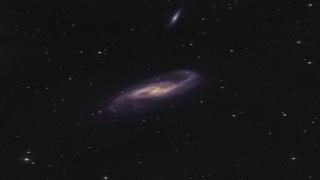Bibcode
Díaz-García, S.; Díaz-Suárez, S.; Knapen, J. H.; Salo, H.
Referencia bibliográfica
Astronomy and Astrophysics, Volume 625, id.A146, 20 pp.
Fecha de publicación:
5
2019
Revista
Número de citas
15
Número de citas referidas
12
Descripción
Rings are distinctive features of many disc galaxies and their location
and properties are closely related to the disc dynamics. In particular,
rings are often associated to stellar bars, but the details of this
connection are far from clear. We have studied the frequency and
dimensions of inner and outer rings in the local Universe as a function
of disc parameters and the amplitude of non-axisymmetries. We used the
1320 not highly inclined disc galaxies (i < 65°) from the
S4G survey. The ring fraction increases with bar Fourier
density amplitude: this can be interpreted as evidence for the role of
bars in ring formation. The sizes of inner rings are positively
correlated with bar strength: this can be linked to the radial
displacement of the 1/4 ultraharmonic resonance while the bar grows and
the pattern speed decreases. The ring's intrinsic ellipticity is weakly
controlled by the non-axisymmetric perturbation strength: this relation
is not as strong as expected from simulations, especially when we
include the dark matter halo in the force calculation. The ratio of
outer-to-inner ring semi-major axes is uncorrelated with bar strength:
this questions the manifold origin of rings. In addition, we confirm
that (i) ˜1/3 (˜1/4) of the galaxies hosting inner (outer)
rings are not barred; (ii) on average, the sizes and shapes of rings are
roughly the same for barred and non-barred galaxies; and (iii) the
fraction of inner (outer) rings is a factor of 1.2-1.4 (1.65-1.9) larger
in barred galaxies than in their non-barred counterparts. Finally, we
apply unsupervised machine learning (self-organising maps, SOMs) to show
that, among early-type galaxies, ringed or barred galaxies cannot be
univocally distinguished based on 20 internal and external fundamental
parameters. We confirm, with the aid of SOMs, that rings are mainly
hosted by red, massive, gas-deficient, dark-matter poor, and centrally
concentrated galaxies. We conclude that the present-day coupling between
rings and bars is not as robust as predicted by numerical models, and
diverse physical mechanisms and timescales determine ring formation and
evolution.
Proyectos relacionados

Las Galaxias Espirales: Evolución y Consecuencias
Nuestro grupo pequeño esta bien conocido y respetado internacionalmente por nuestro trabajo inovativo e importante en varios aspectos de la estructura y la evolución de las galaxias espirales cercanas. Usamos principalmente observaciones en varias longitudes de onda, explotando las sinergías que nos permiten responder a las cuestiones más
Johan Hendrik
Knapen Koelstra